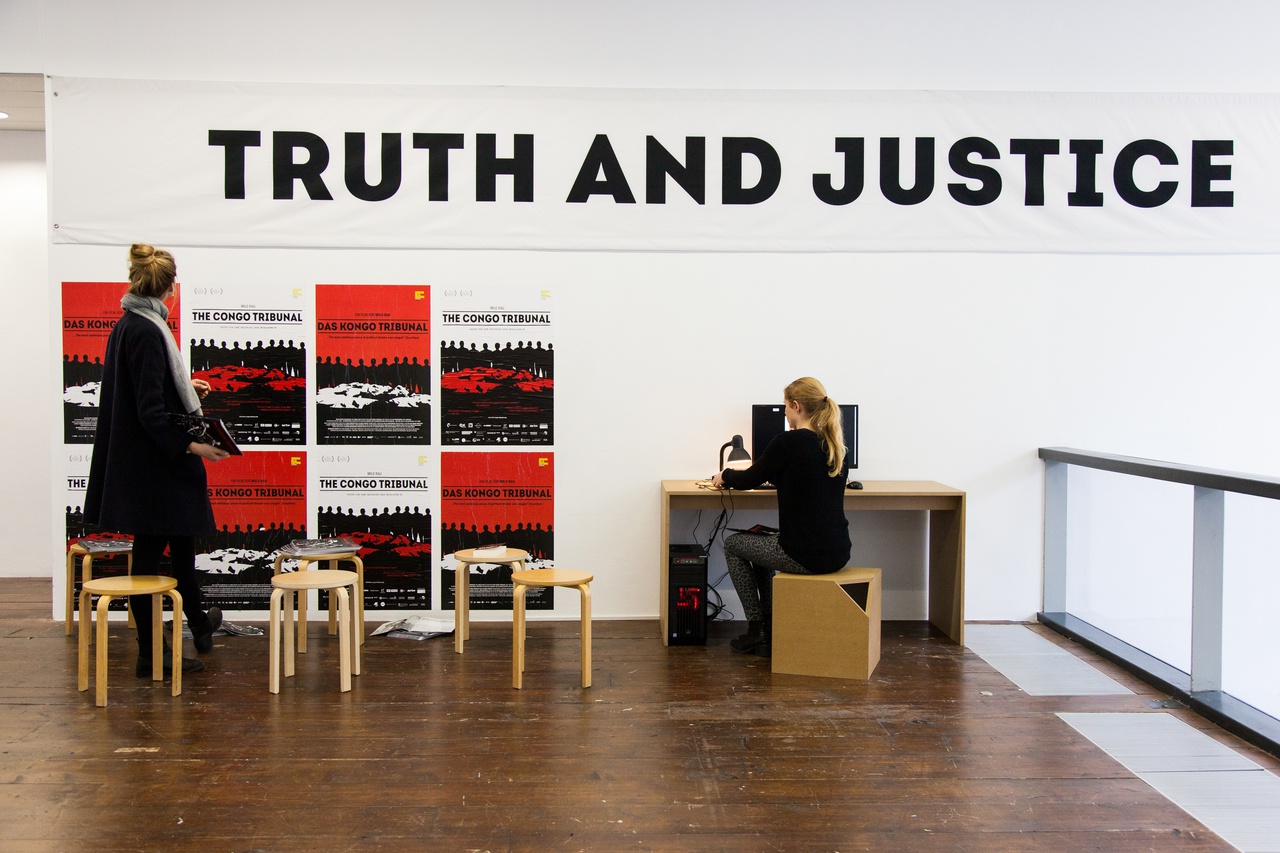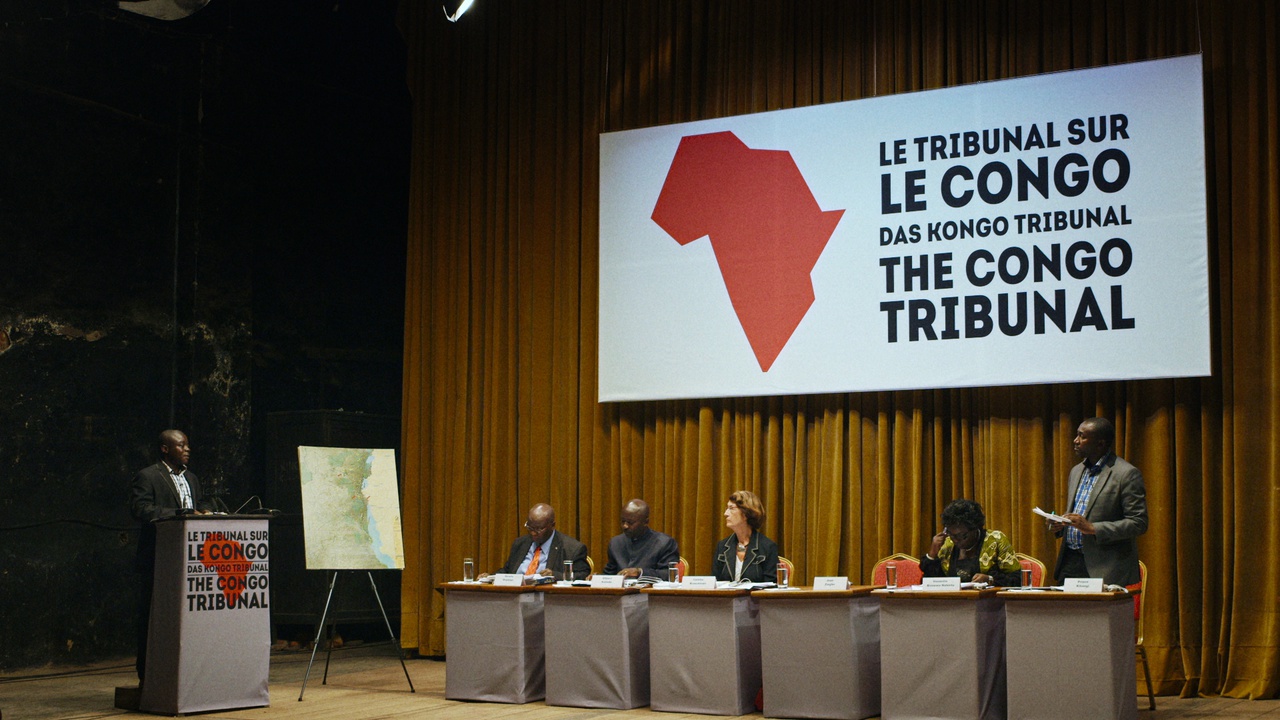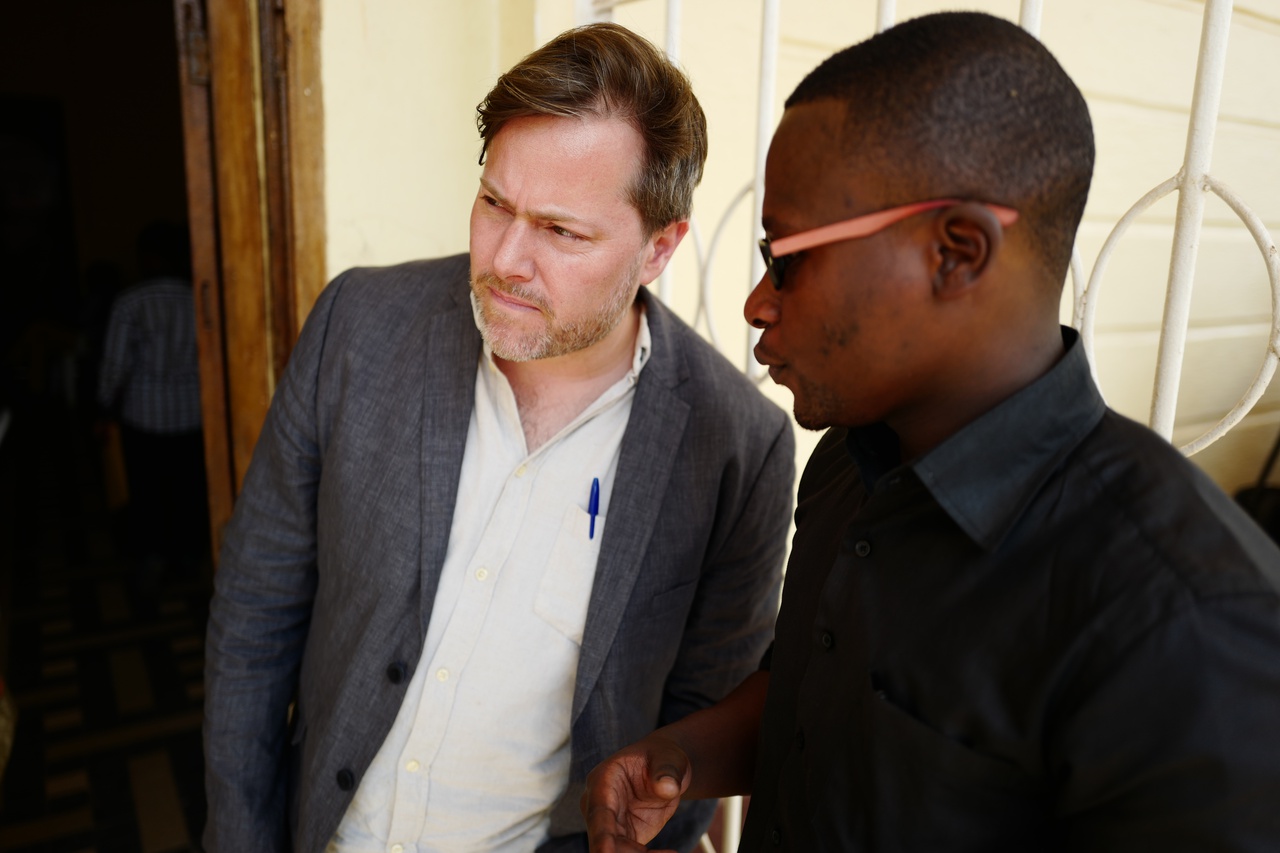Actors and Directors Sven Lütticken on The Congo Tribunal

In the last half year, Milo Rau’s The Congo Tribunal has been on a transmedial journey from book to film to exhibition. The latter was shown at Stroom in The Hague, as well as STUK in Leuven. The tribunal itself had two consecutive iterations: The Berlin Hearings at the Sophiensaele in Berlin in June 2015 built on hearings in Bukavu in Eastern Congo the previous month. In response to endemic violence, the Congo Tribunal sought to identify and accuse the responsible actors—individual and collective or corporate; regional, national and international or global; local guerrilla fighters and ministers as well as mining corporations and NGOs. Rau’s 2017 film has not only been released in cinemas in Europe but also shown and discussed across Congo, establishing a situation of direct feedback. Footage documenting these Congo screenings was in turn part of the Stroom exhibition, which also features other forms of documentation (including full-length recordings of the tribunals in Congo and Berlin), and a VR installation.
Stroom’s long-running “See You in The Hague” program takes its cues from the city’s status as home to the International Criminal Court and related ad-hoc tribunals (such as the one on Yugoslavia), and earlier included the Model Court project by Sidsel Meineche Hansen and Lawrence Abu Hamdan, among others. The mimicking and reenacting of legal procedures continues in the presentation of the Congo Tribunal, which is an artist-led tribunal that has no official status. In this it is part of a larger constellation of historical and contemporary activist and artist-led tribunals, such as the various “people’s tribunals” from the 1960s Russell Tribunal to the present. Rau is well aware of such precedents, with which the Congo Tribunal shares its absolute powerlessness, juridically speaking. One could term this “para-legal” performance: its efficacy lies in publicity, not in the legally binding speech act of a judge or jury. This is reenactment, but one that also intends to serve as prefiguration; a preenactment of a justice to come. This is particularly pronounced in the case of the Congo Tribunal, which was pure preenactment, in the absence of any actual political and/or juridical process that would stop the violence. Rau stresses the factual powerlessness of the tribunal and presents it as a symbolic act that is “das Vorleuchten einer Zukunft, in der dieses Symbolische gewissermassen normal wäre.” [1]
In contrast to the recent activist tribunal NSU-Komplex auflösen, the Congo Tribunal is clearly an authored project. NSU-Komplex auflösen came out of a coalition of activist (migrant) groups seeking to challenge the state’s desire to present the neo-Nazi terror cell NSU as consisting only of a handful of people; with a tribunal in Cologne intended to counter the official trial in Munich, they sought to reveal the involvement of state actors in a wider “NSU complex.” Artists such as Natascha Sadr Haghigian were involved, and Forensic Architecture produced a reconstruction of the murder of Halit Yozgat that was shown at Documenta, but these practitioners were working as part of a self-constituted coalition. By contrast, in the context of the Artist Organisations International network, such as it manifested itself at a rather notorious event at HAU in Berlin, an oddly auteurist approach to para-institutional aesthetic activism appears to have reemerged. [2] Artist organizations such as Rau’s International Institute of Political Murder come to function as the persona ficta in which a neo-Beuysian author-function can be invested.
Some scenes in the film make for uncomfortable viewing: the camera follows the white author-organizer Rau through African masses—like a somewhat less messianic Bono acting for his own NGO. Why keep reenacting this kind of white savior iconography? Not that Rau seems interested in developing a compelling performative persona: the film shows him as pure organizational drive, a kind of degree zero of personality. As problematic as his presence appears in some scenes, it becomes productive in others. Rau is seen announcing that (a certain part of) the tribunal is going to start, and he framed this very explicitly as a film shoot with himself in the director role saying “action.” Whereas the aforementioned scenes appear to regress into documentary clichés with the white identificatory figure for western viewers and funders, here Rau appears to function as a kind of embodied Verfremdungseffekt for a bitterly divided Congolese crowd that can perhaps only come together through such a distancing device.
 Milo Rau, "The Congo Tribunal," 2017, film still, Photo: Fruitmarket
Milo Rau, "The Congo Tribunal," 2017, film still, Photo: Fruitmarket
Rau’s status as auteur allows him to pursue a specific politique des acteurs that is one of the strongest features of his approach. In the film, he mentions wanting to stage “un tableau avec tous les acteurs,” all the individual as well as state and corporate “actors.” In the earlier Moscow Trials, which restaged three Russian trials against artists, Rau took care not to compose the jury only of “our kind of people,” but to include conservatives and reactionaries as well. Furthermore, the artist and their lawyer faced an extremely strong prosecutor. The verdict was anything but a foregone conclusion, even though Rau still rigged the outcome in that the very “balanced” nature of the jury was not representative of the population overall. It is still in striking contrast to some other activist tribunals that Rau involves the Others—the fascists, the corrupt, the ambiguous, the muddlers. At the Bukavu hearings, one of the jurors has close ties to the international mining industry, and grilled witnesses who accused corporations; however, he is highly critical of state actors. Coming in as alien auteur, Rau can stage a show trial with real tension—which sometimes erupts, as when the then governor of South Kivu province intervenes from the audience when the interior minister is making a fool of himself.
Theater is an art of presence, of embodiment. In the “para-legal” form of the tribunal, people congregate to debate crimes and their causes; the tribunal becomes a negotiation with the violence of extraction and abstraction. However, there is always the risk that the presence of individual actors will lead to an excessive “personalization” and localization of the conflict. The Congo Tribunal struggles with this throughout, even in its title, which fails to incorporate what is nonetheless a key point of the entire project: that this is a global conflict that plays out locally. The conflict in Eastern Congo is fueled by international mining conglomerates that take advantage of a legal order that treats the land as terra nullius to which traditional users have no claim; it is stabilized qua conflict by the US and NGOs. Hearings were held in Bukavu and Berlin, and the central cases under examination were the Belgian mining company Banro, the role of NGOs, and the disastrous consequences of the American Dodd-Frank Act, which sought to curb the trade in “conflict minerals” but ultimately triggered more violence because it dramatically increased unemployment.
Whereas the Bukavu Jury focused on the role of various Congolese state and military actors, as well as the role of the MONUSCO UN mission, the Berlin jury focused precisely on the responsibility of corporations, the EU, the World Bank, and the international humanitarian aid industry. And yet…. In European arthouse cinemas, the documentary plays all too easily like another NGO-approved film about a far-away conflict. The footage in the exhibition that shows screenings and discussions in the DRC suggests that it functions in a very different way there, and a film about these film screenings and discussions would in many ways be preferable to the actual film. When it comes to documentation about the tribunal itself, the book does very nicely. Like the film, the exhibition never really turns the tables on the European audience. Both a screen-based game that can also be played in the exhibition and the related VR installation are based on illustrations by the Congolese artist Kayene; both use a black-and-white aesthetic to maintain a sense of estrangement and distance even while they involve viewers in a shooter game in which they are powerless to shoot back; they play the role of Witness J, and live through his experiences. At the end of the VR experience they are invited to approach the witness stand, presumably still in Witness J’s shoes. Is this also possibly meant to suggest that the western viewer—as consumer of the kind of conflict mineral-dependent technology on which the exhibition runs—is fatally implicated? If so, it’s a subtle hint that doesn’t hurt.
 Milo Rau with (Cayene) Yves Kulondwa, court sketch artist of the docu-game "Witness J“
Milo Rau with (Cayene) Yves Kulondwa, court sketch artist of the docu-game "Witness J“
Rau can be linked to certain visual artists from the Artist Organisations International milieu who have abandoned classical institutional critique, as an immanent practice that remains fatally confined by the structures it legitimizes through critique, in favor of an institutional activism that seeks to use institutional and organizational structures to effect change outside of a narrowly defined “field” of art. [3] However, on a vast scale, Rau’s project reveals itself as just as reformist—or realist, as Rau would put it. Activist tribunals have an ambiguous relationship to the law: they exist precisely because international and national law are on the side of neo-colonial invaders or oppressors (Russel Tribunals on Vietnam, South America and Palestine), of Corporations (the Monsanto Tribunal, which took place in the Hague a few years ago), or an unaccountable state apparatus (NSU Komplex). The NSU tribunal ended with an indictment rather than a verdict: precisely because of the sabotage of the official investigations by the security forces and the Verfassungschutz (the domestic intelligence agency), in collaboration with certain political parties, which would have revealed any verdict to have been built on sand. The Congo Tribunal did reach a verdict (both in Bukavu and Berlin), and in general the mimicry of a “real,” UN-sanctioned tribunal is pushed quite far, including the role of lawyer Jean-Louis Gilissen, a habitué of the ICC. The fact that Stroom shows the exhibition in the Hague turns it all the more into a plea to “the international community.” As a preenactment, the tribunal wishes to become a reality; its perlocutionary speech acts, which do not have legal efficacy, should become illocutionary speech acts that do.
Rau likes to invoke the French Revolution, by invoking a General Assembly, for example, which referenced the Assemblée Nationale Constituante that the Third Estate instituted as the nucleus for a liberal society. In Rau’s case, the General Assembly was meant as an attack on those exclusions precisely on which the parliamentary democracy that over time became the post-Revolutionary norm has been based. [4] Rau also notes that decades of intellectual foment laid the groundwork for such new social forms. As society is slipping into neo-feudalism, the forms of national sovereignty, popular representation, citizenship, and human rights that evolved in Europe from the 17th to the 18th century collapse under their constitutive contradictions and exclusions. Universal rights were always particularized, hierarchized, racialized; national boundaries were always harder to cross in one direction than in the other (and harder for individuals than for corporations); citizens were always more fully human than non-citizens. Opting out of a fatally mortgaged international order becomes an attractive proposition. During a conservation with Rau at Stroom, the Congolese author and activist Alphonse Muambi proposed that it may be time for Congo to learn from Kim Jong-un and become an African North Korea. Meanwhile, in Rojava, the Kurds are replacing the nation state with autonomous cantons and parliamentary representation with “Stateless democracy”; a parliament building designed by Jonas Staal (co-organizer of Artist’s Organisations International) has just been inaugurated, as Turkish troops are advancing.
If Rau acts as the organizer who casts and commissions others, Staal’s parliament was in fact a commission. While its forms are not without Bouléean or Constructivist overtones, the parliament in Rojava could indeed be seen as a new type, as the precarious and vulnerable nucleus of a different society. With the Congo Tribunal, and particularly with his choice to closely mimick “official” tribunals, Rau has opted for a compromised form; the same could be said for the form of authorship he exploits. There is much to be said for using the available instruments and detourning them; there is much to be said for pragmatism. Some decide to side with the most toxic mechanisms of contemporary capitalism, from speculating on bitcoin to achieving financial autonomy to trying to use gentrification to make a difference—Renzo Martens’ IHA, again in the Congo. This, too, can be seen as a response to the deadlocks of classical institutional critique, as a different brand of institutional activism. It can profit from the dark accelerationist glamor of “making things worser,” as one artist characterized his motivation for promoting and investing in bitcoin, while presenting itself as the only true form of contemporary realism, of post-naïve pragmatism.
Rau sides with the compensatory mechanisms that are habitually used to fight the “symptoms” and “excesses” of anextractivist global order that is in fact based on violent predations. His supposed Leninist streak notwithstanding, Rau is indeed a realist who tarries and tinkers with historical and flawed forms, sounding out their potential to function nonetheless in the absence of a revolutionary breakthrough. While the Congo tribunal stages and shows incompatibilities – between traditional rights and international trade law, for instance— it also remains entangled in its own contradictions. Far from grandly proclaiming a tabula rasa, it is a chess move in the middle of a minefield. It is fairly obviously a problematic project, but that term need not be purely pejorative, as its chin-stroking usage often suggests. Not many works actually manage to be properly problematic: fragwürdig, worthy of being questioned and unpacked, worked with and worked through.
Sven Lütticken
The Congo Tribunal: A Project by Milo Rau, Stroom Den Haag, March 10 – April 8 2017.
Title image: "Milo Rau: The Congo Tribunal," Stroom Den Haag, 2018, Installation view, Photo: Shari de Boer
Notes
| [1] | Milo Rau (ed.: Eva Bertschy, Rolf Bossaert and Mirjam Knapp), Das Kongo Tribunal (s.d.: Verbrecher Verlag, 2017), p. 22 |
| [2] | See Ekatarina Degot, “The Artist as Director: Artist Organisations International and Its Contradictions,” in Afterall no. 40 (Autumn/Winter 2015), pp. 20-27. |
| [3] | It is worth recalling here that Rau studied with Pierre Bourdieu. |
| [4] | See Milo Rau/IIPM, General Assembly (Leipzig: Merve Verlag, 2017). |
